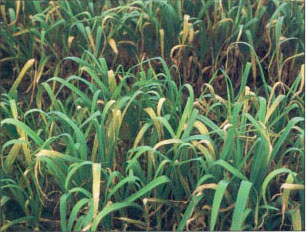All Issues
Science briefs
Publication Information
California Agriculture 52(4):4-5.
Published July 01, 1998
PDF | Citation | Permissions
Full text
Rust disease shrinks garlic crop
The Central Coast's garlic crop is taking a hard hit by rust disease, with some fields suffering 100% plant infection. Losses to Central Coast garlic growers are in the hundreds of thousands of dollars, estimates Monterey Count}' farm advisor Steve Koike. Some industry members have estimated there will be as much as a 75% reduction in tonnage, but the damage exacted will not be known until after harvest is completed in October. Garlic rust has been observed in California since 1934 and appears periodically, but this outbreak is the most severe in 58 years. It began in February; a severe infestation of rust broke out in several garlic fields in Monterey and San Benito counties. It is likely that El Niño's wet, rainy spring encouraged the disease to develop, according to Koike.
Orange fungal spores cover infected leaves, resulting in yellowing, wilting and drying of the leaves.
The rust continued to spread from field to field and growers were unable to control it using the few fungicides registered for use on garlic. Koike says the effectiveness of the fungicides may have been hindered because the disease was already well established when the fungicides were applied.
In fungicide trials conducted by Richard Smith, San Benito County farm advisor, and Koike, only unregistered products including Tilt (propiconazole), Quadris (azoxystrobin) and Folicur (tebuconazole) significantly controlled the disease. Plots treated with tebuconazole yielded 8 tons per acre, whereas untreated garlic plots yielded 2.2 tons per acre. The industry has applied to the California Department of Pesticide Regulation for emergency use permits to use tebuconazole next spring if another outbreak occurs.
“This year there was nothing we could do,” says UC Davis plant pathologist Mike Davis, “but next year if we see this, we probably will have something. It shows we need to be prepared.”
Although garlic rust doesn't kill the plant outright, affected plants produce unmarketable bulbs, Koike explains. The rust causes significant stunting of the garlic bulbs, resulting in shrunken and deformed bulbs, as well as shattering of bulbs that do develop.
Garlic rust is also widespread in the San Joaquin Valley, which grows about 75% of the California crop, from Fresno to Bakersfield. “We have damaging levels in about 20% of the fields,” says Davis. “In the worst infested fields, rust has cut production by 40 to 50%.”
UC Davis vegetable specialist Ron Voss says preliminary reports indicate a 20% overall reduction of the state's crop, which supplies about 90% of the nation's garlic and was valued at $145.6 million in 1996.
The fungus can also infect other Alliums — chives, Japanese bunching onion, leek, onion, rakkyo and shallot — producing symptoms similar to those seen in garlic. Koike has observed that onion fields adjacent to garlic fields are now being infected with the rust. He said that greenhouse studies indicate that onions and chives are susceptible, but the fungus appears to be less virulent on onions.
The disease is identified by small yellow-to-white flecks, streaks and spots on leaves As these small areas expand, the leaf tissue covering them breaks and the orange spores (urediospores) of the fungus become visible as pustules. Severely infected leaves can be almost entirely covered with pustules, resulting in complete yellowing, wilting and drying of the leaf. As the disease progresses, a second spore type (teliospores) may also occur on the same leaves, resulting in black pustules. Severe rust can cause extensive loss of foliage and subsequent reduction in bulb size and quality.
There are no recommendations for preventing the disease. Because garlic rust has been a minor problem until this season, scientists have little information on how the disease develops on garlic. “Typically,” Koike says, “rust can only be controlled with preventive fungicides or resistant cultivars.”
On onions, the fungus survives as either urediospores or teliospores. Urediospores are the more important source of inoculum because they become windborne and can be widely distributed.
Although there may be more spores to infect next year's crop, scientists think the weather is a greater influence on the level of garlic rust infestation. “Weather definitely has something to do with it,” says Davis. “If we have a normal weather year, the incidence will be greater than usual but won't reach the epidemic of this year. Whether it will cause economic damage next year if we have normal weather, I don't know.”
NRS receives $4 million
The UC Natural Reserve System will be able to expand its activities in environmental research and education thanks to a $4 million endowment received from the David and Lucile Packard Foundation.
Specifically, earnings from the new Kenneth S. Norris Endowment Fund for the California Environment will support new and renovated laboratories and lodgings, equipment and environmental monitoring at NRS sites through the state. This will enable the NRS to continue to attract and retain top-notch researchers and to expand upon its public education and outreach programs.
The Norris endowment, named for one of the NRS founders, is the largest single gift ever received by the NRS. The NRS manages 33 wildland reserves, encompassing more than 120,000 acres throughout California.
Insect quarantine facility breaks ground
UC Vice President - Agriculture and Natural Resources Reg Gomes mounted a bulldozer, knocking down an antiquated greenhouse to clear the site for the new insectary and quarantine facility at UC Riverside.
UC Riverside broke ground July 2 for a state-of-the-art insectary and quarantine facility, which will be constructed over 24 months. Research carried out in the facility will focus on biological control and other alternative pest management strategies.
Michael T. Clegg, dean of the College of Natural and Agricultural Sciences, said of the new facility, “It is best to think of it not as a building, but as a complex research machine.” The structure will consist of 2 receiving rooms, 5 research laboratories, 10 greenhouses, and 52 rearing rooms at biosafety levels 1, 2 and 3. Each room must have its own temperature, humidity and lighting controls to mimic climatic conditions hospitable to insects from all over the world.
Before bringing imported insects into the facility, researchers must receive permits from the U.S. Department of Agriculture and California Department of Food and Agriculture, as well as approval from an internal review committee. Once granted, researchers must adhere to a strict protocol for movement of insect and plant materials. Between levels of containment, they must pass through a series of complex airlocks and decontamination rooms.








